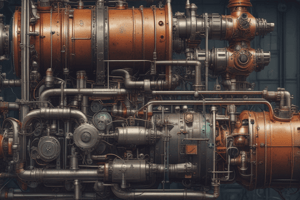Podcast
Questions and Answers
What is the main focus of the course described?
What is the main focus of the course described?
The study of the basic principles and fundamentals of hydraulics, pneumatics, and electro-pneumatics.
Which of the following topics is covered in the course outline? (Select all that apply)
Which of the following topics is covered in the course outline? (Select all that apply)
- Basic Electro-Pneumatics (correct)
- Principles of Hydraulics (correct)
- Basic Logic Circuitry (correct)
- Thermodynamics
The course includes practical exercises.
The course includes practical exercises.
True (A)
What are the two types of actuation mentioned?
What are the two types of actuation mentioned?
The function of a relayed control can be categorized into _____ and _____ functions.
The function of a relayed control can be categorized into _____ and _____ functions.
What does the EN 61082-1:2006 standard pertain to?
What does the EN 61082-1:2006 standard pertain to?
What is the purpose of a double solenoid valve?
What is the purpose of a double solenoid valve?
Match the following hydraulic components with their usage:
Match the following hydraulic components with their usage:
Flashcards are hidden until you start studying
Study Notes
Course Description
- Covers fundamental principles and applications of hydraulics, pneumatics, and electro-pneumatics.
- Includes the interpretation of standard symbols used in these fields.
- Focuses on component familiarization, circuit design, interpretation, and analysis.
Course Outline
- Principles of Hydraulics: Fluid Power and hydraulics, Pressure, force and area, Pascal's Law and Gas Laws.
- Introduction to Pneumatics: Basic pneumatics system, Air production system, Air consuming system.
- Hydraulics, Pneumatics Components: Actuators, Directional valves, Auxiliary valves.
- Basic Circuits: Elementary function (flow, amplification, signal inversion, memory function, delayed switching on, delayed switching off, pulse on).
- Basic Rules in Circuit Diagramming: The rest position, Circuit lay-out and guidelines, Motion and step diagram, Sequence charting.
- Basic Electro-Pneumatics: Direct and Indirect control, Logic functions, Dominant set/reset memory, Time dependent control, Sequence control.
Electropneumatic/Hydraulic Control and Design
- The course aims to guide students to the fundamentals of electro-pneumatics/hydraulics.
- Students will become familiar with industrial elements, their characteristics, functions, and symbols.
- Course teaches students to design, build, and maintain electro-pneumatics/hydraulic systems and controls independently.
Topic Outline: Hydraulic Controls and Design
- Application of hydraulics
- Types and properties of hydraulic fluids
- Hydraulic power generation and transmission
- Standard hydraulic symbols
- Hydraulic working elements
- Hydraulic valves and components
- Electro-Hydraulic controls
- Practical Exercises
Basic Logic Circuitry Using Relay Control
- Allocation/Assignment:
- Negation (NOT Function): Inverts the input signal.
Direct and Indirect Signal Actuation
- Direct Electrical Actuation: Input directly powers the load. Disadvantage: no electrical isolation between control and power circuits, limited output capacity.
- Indirect Electrical Actuation: Input activates a relay, which then actuates the load. Advantage: electrical isolation, multiple output capabilities.
Basic Logic Circuitry Using Relay Control (Cont.)
- AND Function: Requires all inputs to be active for the output to be activated.
- OR Function: Only requires one active input for the output to be activated.
Signal Storage in the Control Section
- Dominant-ON: Output is activated if both ON and OFF switches are activated.
- Dominant-OFF: Output is deactivated if both ON and OFF switches are activated.
Signal Storage in the Power Section
- Double Solenoid Valves inherently store signal actuation and valve position state.
- A pulse on one solenoid coil switches the valve to a corresponding position, which is maintained until a pulse is applied to the other coil.
Reading and Interpreting Circuit Diagrams
- Electrical circuit diagrams are standardized drawings documenting the electrical connections within a system.
- They do not show actual installation or wiring routes, but depict how devices are interconnected.
- Circuit diagrams include device designation codes for tracing and troubleshooting, as well as device information (rated speed, cable diameter).
- EN 61082-1:2006, IEC 60617 & EN 81346-2 are standards for preparing electrotechnical diagrams.
Studying That Suits You
Use AI to generate personalized quizzes and flashcards to suit your learning preferences.




